

Call to scrap maths ability groups at age 7 to boost 'progression' Scrapping primary school maths groups that separate children based on their ability would improve overall achievement and encourage more girls to pursue the subject, new research suggests.
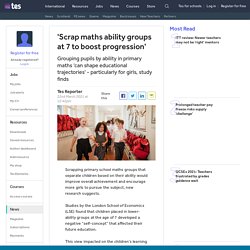
Studies by the London School of Economics (LSE) found that children placed in lower-ability groups at the age of 7 developed a negative “self-concept” that affected their future education. This view impacted on the children’s learning behaviours, subject choice and specialisms, attainment and adult careers, the studies found. Read: England's pupils among the most segregated by ability Opinion: ‘Grouping primary children by ability is indefensible’ Classroom practice: The 12 dos and don’ts of setting The research, funded by the British Academy, analysed data for 4,463 children from the Millennium Cohort Study – 2,299 girls and 2,164 boys. Maths Resources. Maths: early years foundation stage Bloomsbury Early Years Website:
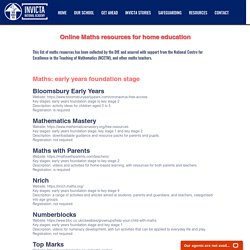
Harnessing the power of story. How might picture and story books enhance the mathematical experience we offer our young children, birth to seven?

This blog has been jointly written by Cath Gripton and myself, as ECMG members. All children are entitled to a strong mathematical foundation which is achieved by the integration of both child- initiated play and adult teaching through meaningful contexts. Young children are naturally mathematical problem solvers, inquirers and sense-makers. Adults encourage children to be mathematical in a range of settings and to reason and to solve mathematical problems in context. Contexts are therefore crucial for children to mathematise their experiences in a way that is meaningful to them. eCPD – recommendations for maths teachers while working from home – Teach innovate reflect. Amidst the current situation in maths departments in the country and working from home, I thought it would be useful to curate some maths specific CPD that staff could maybe look at to break up the working from home day with other jobs that may have been delegated.

I’ve tried to go for a variety of topics and authors. It may be best to direct different staff to different sources and then ask them to come back and discuss, summarise, share ideas and put an implementation plan together. Firstly, I designed some infographics that are created using Oli Caviglioli’s principles: Explanation and modelling in maths visual summary Increasing rigour in the maths classroom – a visual summary of Dani Quinn’s blog “What are you thinking?”
Where is the overlap between learning at home and online learning? The terms remote learning, online learning and home learning are currently used to mean similar things… so, are they interchangeable?
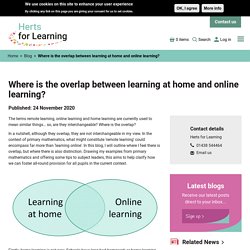
Where is the overlap? In a nutshell, although they overlap, they are not interchangeable in my view. In the context of primary mathematics, what might constitute ‘remote learning’ could encompass far more than ‘learning online’.
NCETM. Calculation Policies. Maths resources websites. Classroom Multiplication Games - Teach with Holly Rachel. Classroom multiplication games are a great way to reinforce times table facts.
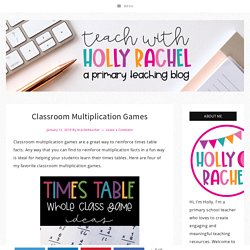
Any way that you can find to reinforce multiplication facts in a fun way is ideal for helping your students learn their times tables. Here are four of my favorite classroom multiplication games. Around the World One student stand up and is ‘on’. They stand behind the student next to them (who remains seated in their chair). Fizz Buzz A classic! Times Table Scavenger Hunt On a piece of card, write a multiplication question. Maths Topic Summaries Y3&4. I See Maths - Gareth Metcalfe Primary Maths Consultancy. Mathematical Exploring at Home. Here's something for all of those that requested something to challenge their secondary pupils (as well as some Year 6 children who want a challenge to support Year 6-7 transition).Here's a link to a Google Drive of Resources and there's some handy websites below.
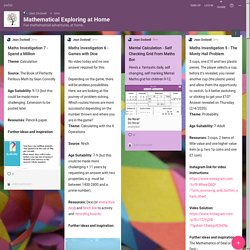
My Favourite 8 Mathematics Websites/Resource Links for Years 6-9 · The late Mathematics Professor Dr Malcolm Swan produced resources that have stood the test of time and approaches and ideas have always supported what is effectively good teaching. CanDoMaths. How to crack written arithmetic with Daily Practice – Mr Andrew's Primary Ideas and Resources. With a larger demand placed on written arithmetic skills since the 2014 overhaul of the National Curriculum, every teacher is wanting to maximize their efficiency in teaching these objectives.
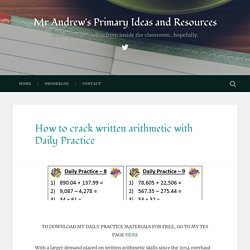
Everyone’s heard someone around February time in the staff room saying something along the lines of: “I just don’t understanding why they can’t do long multiplication any more…they were experts in October when we did it! Guess I’ll have to have a re-cap week of it…” This often comes at a cost of a geometry/measurement/something-other-than-arithmetic module, leaving children short-changed with their knowledge in those areas. MEDIAN Don Steward mathematics teaching. Moodle. Mental mathematics fluency and the importance of perspective – Primary Colour. Star words. Maths steps to success. Maths concept books – Mrs F's Classroom. Posters Archives. Structures of Subtraction - What's the Difference? As one of the four number operations, subtraction is a concept that is familiar – and indeed possibly routine – to every primary school teacher.

Yet, it is perhaps surprisingly complicated. Subtraction has three separate structures. Many pupils’ conceptual misunderstandings of subtraction originate in their lack of awareness of these structures, resulting in pupils at the end of primary school struggling to answer seemingly simple questions such as, “The population of Cambridge is 125,000 and the population of Bedford is 89,000. How many more people live in Cambridge than Bedford?”. Many pupils respond, Pavlovian-esque, to the word ‘more’ and add, calculating the answer as 214,000. Reduction is the most easily understood of the structures, and the one that children encounter most often in everyday life. These reduction stories need to be carefully considered to ensure that reduction which is being explored. The second model of subtraction is partitioning. Multiplications Tables Check - Timestables.co.uk. Multiplication tables check.
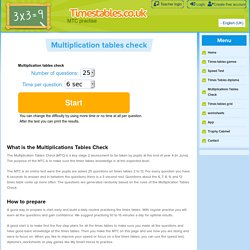
e0d30edefdd1e493b900fe98bde322bclgiqdpnuf0fca6y1o49zzry2otrg6jqig8i2824ak0y0lonwhsnjojvz26qr8hojl17gjhdp7ta86fn30iogj6js89g1zppee0fo. Multiplication Tables Check - Mathsframe. Primary Magazine - Issue 29: Focus on. Like the concept of infinity, prime numbers fascinate children and adults alike. For a mathematician, the greatest achievement is to find the highest known prime number. At the time of writing, the highest known prime is 243112609-1. Numbers as Shapes. The Largest Known Primes. Contents: Primes: [ || | | | | | ] Note: The correct URL for this page is The site The Top Twenty is a greatly expanded version of this information.
This page summarizes the information on the list of 5000 Largest Known Primes (updated hourly). The complete list of is available in several forms. 1. Early Math Collaborative Erikson Institute. The teacher as researcher / teaching as researching. Introduction: In 2007 Caroline Ainsworth, became interested in the use of Cuisenaire rods as a tool for teaching and learning mathematics. Madeleine Goutard and Cuisenaire rods. Not the least of her talents is the ability to express simply, accurately and concisely ideas that in my words remain obscure to many. And they are sometimes, his words. I'm convinced that Gattegno was proposing an approach to teaching that put the learner at the centre and encouraged their initiative, understanding, communication. Following Learning. Untitled. Early Number Sense - I See Maths. Activities The Count On Races game, played by an adult and a child, helps children learn to count on mentally. A coin or a dice with 1 or 2 on each face is used.
Children say the next number when counting on. For example, when starting from 7, for a jump of 2 we say '8,9'. The Cube Model (4-6) and Cube Model Advanced (4-6) tasks, children recreate the models. The Reasoning in Addition Puzzles get children thinking deeply about the value of different shapes. Year 4 Multiplication & Times Tables Check - What You Should Know. Round the Three Dice. Number Bonds – The Other Essential Building Blocks to Success in Maths. Progression of Skills. Telling the time homework. Fluency Without Fear. Download PDF. What is Number Sense? YR5 NFRA 11 : Recognise the percent symbol (%) and understand that percent relates to ‘number of parts per hundred’, and write percentages as a fraction with denominator 100, and as a decimal. Teaching Probability- some thoughts... Learning by Questions. SSDD Problems – Same Surface, Different Deep Structure maths problems from Craig Barton @mrbartonmaths. Adding fractions - squeaktime.com.
MathsBot.com - Tools for Maths Teachers. 5-a-day Primary. Bronze, Silver, Gold and Platinum – KS2 SATs style questions in increasing difficulty January 1st January Bronze Silver Gold Platinum 2nd January Bronze Silver Gold Platinum. How to crack written arithmetic with Daily Practice – Mr Andrew's Primary Ideas and Resources. Dyscalculia. Your Maths, your career. BR2-U3-EQuIP_0. KS2 KS3 Maths Guidance 2017. Guest Blog: Mastery and maths - how our guidance can help. Professor Jeremy Hodgen – Chair of Mathematics Education at the UCL Institute of Education – led the evidence review underpinning the recent EEF guidance report, 'Improving Mathematics at Key Stages 2 and 3. In this blog, he discusses the links between the guidance and mastery learning. Since the EEF guidance report was published, several teachers have asked me if the guidance encourages mastery.
The short answer is yes. The starting point for the guidance was a series of questions from teachers about the effective ways of enabling all pupils to succeed mathematically. JUMP Math, a teaching method that's proving there's no such thing as a bad math student. 3 Teaching Techniques That Made My 2014 - David Thomas' Blog. At the start of this academic year I wanted to really put the theory of learning I knew into practice.
Here are three teaching techniques I tried that I’ll be taking with me into 2015. 1. Visual Games - I See Maths. Quantity Bingo. Finger Activities vF. The Recovering Traditionalist - Working to help teachers think outside the traditional way of doing, and teaching, mathematics. Questioning My Metacognition. PA Maths - Primary Advantage. 2d shapes. Triangles. Why the right answer should not be the primary maths aim. Sign in to your account. Year 3 Mini-Maths. Mr Reddy Maths Blog. Talk4Maths – Developing a World-Class Maths Model by @Mroberts90Matt – Teacher Voice. Why I banned marking in primary maths. Memory and the primary mathematics classroom. – The Golden Spiral. Visual Calculation Policy for Primary Schools. Talk4Maths – Developing a World-Class Maths Model by @Mroberts90Matt – Teacher Voice.
Math talk mat (1) 11 maths podcasts to get you ready for the new term. Please, no more rubbish about times tables! – The World Is Maths. Visual Supports - I See Maths. Explanation of the strategy stages teacher pdf. Questioning My Metacognition. Visual Representations. Fraction Cards. Sign in to your account. Times Tables Tracker. Teaching Your Class to Roll Numbers. Mr Reddy Maths Blog. Inspiring Students to Math Success and a Growth Mindset. Educating MrMattock. Fractions shed. Interactive Fraction Wall.